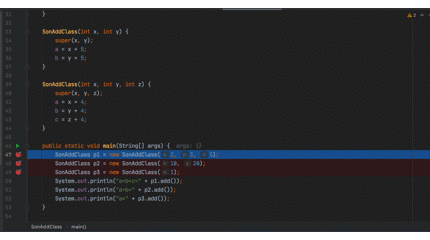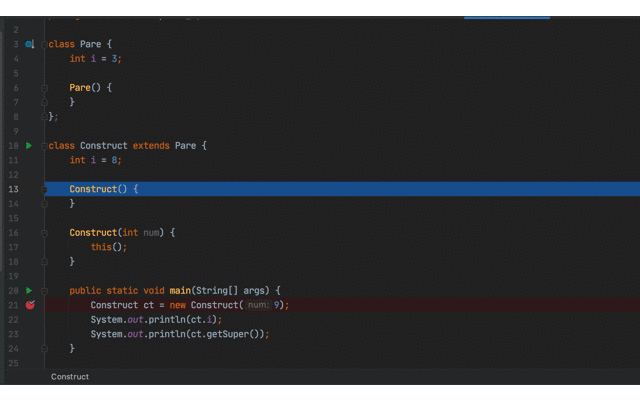题目:
- 实验:利用IDE的debug功能给例6.4和例6.6的new语句设置断点,使用单步调试(step into/step over)跟踪子类对象实例化(初始化)的执行顺序,并总结该过程。(教材:Java面向对象程序设计,第二版,袁绍欣主编)
- 如何实现两个对象之间互发消息,请举例说明。
- 谈谈组合与继承的区别以及两者的使用场景(即什么时候宜用组合?什么时候宜用继承? )。
- Java中的运行时多态的含义是什么?有什么作用?请举例说明。
- 使用接口改写例6.8中的程序。
- 简述运算符instanceof的使用场景。
1. 实验:利用IDE的debug功能给例6.4和例6.6的new语句设置断点,使用单步调试(step into/step over)跟踪子类对象实例化(初始化)的执行顺序,并总结该过程。
下面给出6.4调试动图(大小限制,该动图尺寸不大)
下面给出6.6调试动图
程序说明:
package bookcode.ex6.part6_6;
class Pare {
int i = 3;
Pare() {
super();
}
};
class Construct extends Pare {
int i = 8;
Construct() {
}
Construct(int num) {
this();
}
public static void main(String args[]) {
Construct ct = new Construct(9);
System.out.println(ct.i);
System.out.println(ct.getSuper());
}
int getSuper() {
return super.i;
}
}
先执行的是子类的this(),Construct()中有一个隐含的super(),使得类Construct在生成对象时,父类 i=3 显式初始化能够执行。
实例化执行顺序总结:
- 为子类对象分配内存空间,对域变量进行默认初始化。
- 绑定构造方法,将new对象中的参数传递给构造方法的形式参数。
- 调用this或super语句,二者必居其一,也只有一。
- 进行实例变量的显式初始化操作。
- 执行当前构造方法体中的程序代码。
2. 如何实现两个对象之间互发消息,请举例说明。
使用引用的属性或方法其实都是调用对象的属性或方法,而消息概念的引入就是为了说明这样的过程。消息的实质就是引用向对象发出的服务请求,是对数据成员和成员方法的调用。下面列举能否发送消息的三个条件:
- 引用必须真实引用了特定的对象,否则会抛出NullPointerException异常。
- 访问对象必须定义了相应的属性或方法,否则编译不会通过。
- 被访问的属性或方法必须具有可访问的权限。
消息也就是相当于在遥控器和显示器之间架起沟通的桥梁。在面向对象语言中,消息把不同对象相互联系起来,共同完成特定功能。
实例代码:
class FighterPlane {
String name;
int missileNum;
public FighterPlane(String _name, int _missleNum) {
this.name = _name;
this.missileNum = _missleNum;
}
public void fire() {
if (this.missileNum > 0) {
System.out.println("now fire a missile !");
this.missileNum -= 1;
} else {
System.out.println("No missile left !");
}
}
}
class A {
FighterPlane fp;
public A(FighterPlane fpp) {
this.fp = fpp; //A对象中拥有了FighterPlane对象的引用
}
public void invoke() {
//A对象发送消息给FighterPlane的对象
System.out.println(fp.name);
}
}public class Run {
public Run() {
}
public static void main(String[] var0) {
FighterPlane ftp = new FighterPlane("su35", 10);
//产生A对象,并将ftp作为对象引用传入
A a= new A(ftp);
a.invoke();
}
}
3. 谈谈组合与继承的区别以及两者的使用场景(即什么时候宜用组合?什么时候宜用继承? )。
- 组合:通过对象内部的属性引用来实现。使对象之间的耦合性较为松散。
- 继承:从已有的类派生出新的类。在不同的类中也可能会有共同的特征和动作,可以把这些共同的特征和动作放在一个类中,让其它类共享。因此可以定义一个通用类,然后将其扩展为其它多个特定类,这些特定类继承通用类中的特征和动作。继承是 Java 中实现软件重用的重要手段,避免重复,易于维护,易于理解。
- 组合就像房间里面的窗户、墙壁、地板、桌子、椅子等,他们之间并不存在结构上的相似性,只是功能上组合可以发挥更大的作用,但是单独是可以独立运行的。继承就像对房间进行拓展成为一栋楼,前面的零部件它都具备,但是如果没有房间,大楼是无法构建的,具有结构和功能上的关联。
- 显而易见,在不具有结构和功能上的相似性时,使用继承可以减少代码重复率,易于维护;在结构实现不同、功能“可叠加”时,使用组合无疑是优于继承的。
4. Java中的运行时多态的含义是什么?有什么作用?请举例说明。
Java提供了两种多态机制——重载和覆盖。运行时多态指的是覆盖,在运行时根据输入参数动态选择不同的 成员方法执行,体现了一个类本身的多态性,使代码具有良好的拓展性。
举例:同样的红烧鱼,厨师老师的红烧方法传给厨师徒弟后,厨师徒弟在红烧方法上做了改动,这是红烧方法的重写,就相当于 java 的方法重写。
重写代码如下:
class Ct{
void hongshao(int a){
System.out.println("这是厨师老师的红烧int的方法");
}
}
class Cs extends Ct{
void hongshao(int a) {
System.out.println("这是厨师徒弟的红烧int的方法");
}
}
重载代码如下:
class Cs extends Ct{
void hongshao(int a) {
System.out.println("这是厨师徒弟的红烧int的方法");
}
void hongshao(float b) {
System.out.println("这是厨师徒弟红烧float的方法");
}
void hongshao(int a,float b) {
System.out.println("这是厨师徒弟红烧int和float的方法");
}
}
5. 使用接口改写例6.8中的程序。
创建接口
package bookcode.ex6.part6_8;
public interface Shape {
double getArea();
double getPerimeter();
void show();
}
圆类
package bookcode.ex6.part6_8;
public class Circle implements Shape{
private int r;
public Circle(int _r){
r = _r;
}
@Override
public double getArea() {
return r * r * Math.PI;
}
@Override
public double getPerimeter() {
return 2 * Math.PI * r;
}
@Override
public void show() {
System.out.println("Circle Area:" + getArea());
System.out.println("Circle Perimeter:" + getPerimeter());
}
}
矩形类
package bookcode.ex6.part6_8;
public class Rect implements Shape {
private int k;
private int m;
public Rect(int width, int height) {
k = width;
m = height;
}
public double getArea() {
return (k * m);
}
public double getPerimeter() {
return (2 * k + 2 * m);
}
@Override
public void show() {
System.out.println("Rect Area:" + getArea());
System.out.println("Rect Perimeter:" + getPerimeter());
}
}
三角形类
package bookcode.ex6.part6_8;
import com.sun.tools.javac.file.SymbolArchive;
public class Triangle implements Shape{
private int x, y, z, m;
public Triangle(int _x, int _y, int _z){
x = _x;
y = _y;
z = _z;
m = (x + y +z) / 2;
}
@Override
public double getArea() {
return (Math.sqrt(m *(m - x) * (m - y) * (m - z)));
}
@Override
public double getPerimeter() {
return 2 * m;
}
@Override
public void show() {
System.out.println("Triangle Area:" + getArea());
System.out.println("Triangle Perimeter:" + getPerimeter());
}
}
运行
package bookcode.ex6.part6_8;
public class RunShape{
public static void main(String args[]){
Rect rect = new Rect(5 , 6);
Triangle triangle = new Triangle(3, 4, 5);
Circle circle = new Circle(5);
rect.show();
System.out.println();
triangle.show();
System.out.println();
circle.show();
}
}
6. 简述运算符instanceof的使用场景。
instanceof 是 Java 的一个二元操作符,instanceof 是 Java 的保留关键字。它的作用是测试它左边的对象是否是它右边的类或子类的实例,返回 boolean 的数据类型。
package bookcode.ex6.part6_15;
class Uncle{}
class Pare{}
class Pare1 extends Pare{}
class Pare2 extends Pare1{}
public class InstanceofTest {
public static void main(String args[]) {
Uncle uncle = new Uncle();
Pare pare = new Pare();
Pare1 pare1 = new Pare1();
Pare2 pare2 = new Pare2();
//验证pare
if (pare instanceof Pare) {
System.out.println("pare instanceof Pare");
}
if (!(pare instanceof Pare1)){
System.out.println("pare not instanceof Pare1");
}else if (pare instanceof Pare1){
System.out.println("pare instanceof Pare1");
}
if(!(pare instanceof Pare2)){
System.out.println("pare not instanceof Pare2");
}else if (pare instanceof Pare2){
System.out.println("pare instanceof Pare2");
}
System.out.println();
//验证pare1
if (pare1 instanceof Pare1) {
System.out.println("pare instanceof Pare");
}
if (!(pare1 instanceof Pare)){
System.out.println("pare1 not instanceof Pare");
}else if(pare1 instanceof Pare){
System.out.println("pare1 instanceof Pare");
}
if(!(pare1 instanceof Pare2)){
System.out.println("pare1 not instanceof Pare2");
}else if(pare1 instanceof Pare2){
System.out.println("pare1 instanceof Pare2");
}
System.out.println();
//验证pare2
if (pare2 instanceof Pare2) {
System.out.println("pare instanceof Pare");
}
if (!(pare2 instanceof Pare)){
System.out.println("pare2 not instanceof Pare");
}else if (pare2 instanceof Pare){
System.out.println("pare2 instanceof Pare");
}
if(!(pare2 instanceof Pare1)){
System.out.println("pare2 not instanceof Pare1");
}else if (pare2 instanceof Pare1){
System.out.println("pare2 instanceof Pare1");
}
System.out.println();
//验证uncle
if (uncle instanceof Uncle){
System.out.println("uncle instanceof Uncle");
}
// 语法错误,无法编译通过
/*
if (uncle instanceof Pare) {
System.out.println("uncle instanceof Pare");
}else {
System.out.println("uncle instanceof Pare");
}
if (!(uncle instanceof Pare1)){
System.out.println("uncle not instanceof Pare1");
}else {
System.out.println("uncle instanceof Pare1");
}
if(!(uncle instanceof Pare2)){
System.out.println("uncle not instanceof Pare2");
}else {
System.out.println("uncle instanceof Pare2");
}
*/
}
}

